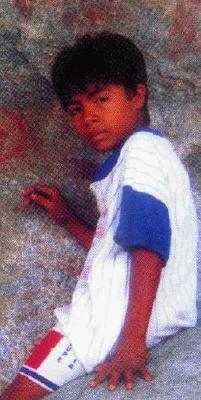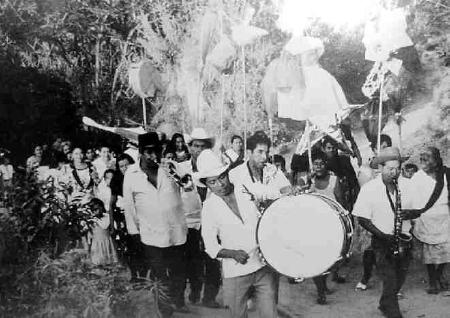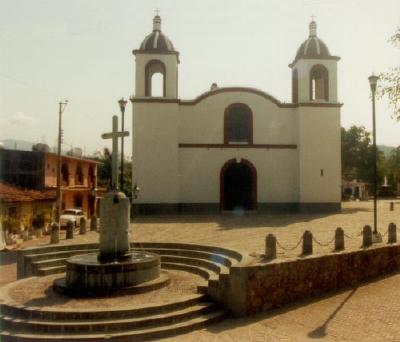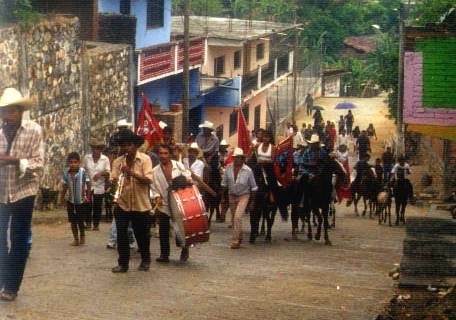

Sun 7
Daylight Savings Time
It's back to normal, after last year's experiment in a shorter DST period. It takes effect at 2
a.m. on the first Sunday of April, when clocks are to be set forward one hour (i.e. 2 a.m.
becomes 3 a.m.).
Tue 9
Chacahua Fair
Part of the celebration of the founding of Tututepec (see Thu 11 - Sun 14
below). The program in this community in the Chacahua National Park includes:
6 a.m. Surf Demonstration
10 a.m. Beach Football
12 p.m. Round Table on the management of the resources of the Tututepec municipality.
9 p.m. Popular Dance
Wed 10
Zapotal Fair
See above (and below):
9 a.m. Volleyball
2 p.m. Gastronomy Fair
3 p.m. Decorated Canoe and Dugout Contest
4 p.m. Motor launch and rowboat Contest
5 p.m. Cultural Event
9 p.m. Popular Dance
Zapotalito, Chacahua
Anniversary of the Death of Emiliano Zapata
Lured into a treacherous ambush by Col. Jesús M. Guajardo in Chinameca, Morelos on April
10, 1919, the untainted hero of the Mexican Revolution died with ten of his followers.
Time has not diminished the appeal of Zapata nor the power of his political message. Flags are flown at half mast on public buildings.
 Thu 11 - Sun 14
Thu 11 - Sun 14
1645th Anniversary of Founding of
Tututepec
At the time of the Spanish conquest (1519-1522), the Oaxacan coastal region had long been under
the control of a Mixtec dynasty based in Tututepec.
According to interpretation of surviving Mixtec codices, in 357 AD. the king of Tilantongo sent Prince Matatzín to lead 20,000 families, the high priest of Achiutla and 50 other priests to colonize the rich lands and trading routes of the coastal plains.
The town of San Pedro Tututepec, now known as Villa Tututepec de Melchor Ocampo celebrates this long history of continual population this month.
For more on Tututepec, see the story.
The program includes:
Thursday 11
10 a.m. Crafts, Food, Archeological, Painting and Agricultural Expos begin.
12 p.m. Inaugural Ceremony
12:30 p.m. Environmental Conferences
5 p.m. Cultural Event
Friday 12
12 p.m. Food Fair presented by Puerto Escondido's Restaurant Association
1 p.m. Concert by the excellent Orquesta Primavera
4 p.m. Cock Fights
5 p.m. Cultural Event
9 p.m. Dance
Saturday 13
2 p.m. Cock Fights
5 p.m. Cultural Event
Sunday 14
1 p.m. Closing ceremony and Cultural Event
4 p.m. Five Star Rodeo
Fri 12
New Moon in Aries
at 2:21 p.m.
Mon 22
Anniversary of the Beginning of the Mexican Conquest
Two years after the discovery of Mexico and 27 years after the discovery of America, Capt.
Hernán Cortés disembarked on Good Friday, 1519 near what was to become Veracruz to
launch the Spanish Conquest of Mexico.
The expedition comprised 11 ships carrying 500 soldiers, two crossbowmen, 13 musketeers, 18 horses, 14 artillery pieces, 109 sailors and 200 Indian guides and bearers.
Cortés called the place Villa Rica de la Vera Cruz, Rich Town of the True Cross, and founded the first European town in America.
Fri 26
Full Moon in Scorpio
at 10:00 p.m.
Tue 30
Children's Day
A special day devoted to children was established in Mexico in 1924, shortly after the Geneva
Declaration on the Rights of Children was issued calling on all the nations of the world to protect
and cherish the young.
It has developed into a kind of Christmas with gifts of candy and toys. Puerto Escondido DIF, a family and child welfare agency and the local FM radio station, Radio Esmeralda, both host toy drives so that needy kids can also enjoy a day of happiness. You can donate toys to either one.
Call the Agencia Municipal at 582-0155 or Radio Esmeralda at 582-0374.
And don't forget your favorite neighborhood urchins.
Thu 2 - Fri 3
Feast of the Holy Cross
Major religious fiesta celebrated in many communities, but especially important in Santa Cruz
and Santos Reyes Nopala.
Fri 3
Bricklayer's Day
Just about every trade or profession in México has a day to recognize its contribution to
society. This one's for all those involved in construction, a not inconsiderable activity in Puerto
Escondido. As it is also the day of the Holy Cross, crosses are often placed at building sites.
Not very much concrete will be poured today (nor tomorrow).
Radio, Radio
Sunday 8 p.m. to 10 p.m.
Chiles y Chocolates, a bilingual radio
program hosted by "Lucy Sonido", actually Canadian musicologist Helena Szutska, an eclectic mix of
music from around the world.
Wednesday 3 p.m. to 4 p.m.
La Luciernaga (Firefly)
Lucy's midweek, commercial-free hour of free-flowing music.
Saturday 11 a.m. to noon
Lucy's Cuban and salsa music.
Radio Esmeralda, 94.1 FM.

While the field was not as large as was hoped, it attracted some of the true superstars of international longboard: Joel Tudor, Lance Hookano, Duane de Soto, Josh Baker and Dino Miranda among them. Also present again was the amazing Kim Hamrock, the only woman who regularly goes up against the guys in major competition.
The tournament started slowly; it was canceled on Day One for lack of decent waves. Competition got underway on Day 2 with a gentle surf of 2 to 3 feet. By Day 3 it had built to an excellent 4 to 6 feet. From then on, the conditions were perfect: 4 to 8 feet barrels that allowed the experts to demonstrate their considerable skills for the judges whose scoring depended on how long the surfers spent inside the tubes.
How good were the conditions? Well the judges awarded 3 perfect 10's during the contest! The Mexican contingent made a good showing, but, in the end, it was the Hawaiians who took top honors.
"Man, Puerto Escondido is awesome," claimed Duane de Soto, after he was crowned 2002 champion with the ceremonial headdress..
Our congratulations to Angel Salinas, who worked miracles to salvage the tournament of last fall's tragic events. And our thanks to the sponsors, who made it possible for world class surfing action to return to Puerto Escondido. The next edition of this event will return to its September slot. We'll let you know as soon the dates have been announced.
1) Duane de Soto (Hawaii)
2) Dino Miranda (Hawaii)
3) Scott Chandler (USA)
4) Joel Tudor (USA)
5) Josh Baxter (USA)
5) Danny Cortazzo (USA)
7) Lance Hookano (Hawaii)
7) Pete Johnson (USA)
9) Guy Pere (Hawaii)
10) Taitten Cowan (USA)
11) Kim Hamrock (USA)
11) Pablo Bonilla (Mex.)
11) Roberto Alamillo (Mex.)
11) José Manual Cano (Mex)
11) Takuni Takami (Japon)
11) Gus McConnell (USA)
SURF NOTES:
Pto. Escondido dominated last month's two-part Mexican National Championship held in Rio Nexpa, Michoacan and Bonfil, Acapulco.
Local competitors won 2nd in longboard,1st, 2nd and 3rd in women's boogie, 1st and 2nd in junior in Rio Nexpa. In Bonfil it was 1st in junior, 1st, 2nd and 3rd in boogie, 1st in longboard and 1st in men's open for Puerto.
A particular standout was 15 year-old Angelo Corzo, the new Mexican junior champion. The winners have qualified to represent Mexico in world team competition in Durban, South Africa in May. But they are going to need some help to cover the costs.
If you can lend some support, contact us at El Sol de la Costa (582-2230) and we'll connect you with the team coordinators.
 April marks the anniversary of the founding of the town of Tututepec: the 1,645th! It's also the
anniversary of the City of Oaxaca, a modest 470 years old (as an official city, that is). Read on
about these, as well as some history, legends and tales of several other nearby, fascinating places.
April marks the anniversary of the founding of the town of Tututepec: the 1,645th! It's also the
anniversary of the City of Oaxaca, a modest 470 years old (as an official city, that is). Read on
about these, as well as some history, legends and tales of several other nearby, fascinating places.
I'd like to dedicate this issue to some of my neighbors and friends who have inspired this endeavor with their research, recollections and, most of all, their passion for the past.
- - Warren Sharpe
At the time of the Spanish conquest (1519-1522), the Oaxacan coastal region had long been under the control of a Mixtec dynasty based in Tututepec. According to interpretation of surviving Mixtec codices, on April 3, 357 AD, the king of Tilantongo sent Prince Matatzín to lead 20,000 families, the high priest of Achiutla and 50 other priests to colonize the rich lands and trading routes of the coastal plains. The place they chose they called "Yucu Saa" (Hill - yucu of the Birds - saá ), named for the pyramid-like peak covered with seabirds that they encountered. Matatzín found this to be a propitious sign and, when they had climbed to the summit, they were awed by the view: the wetlands of Chacahua; the great Pacific; the green plains and the mountains beyond Pochutla and Juquila.
This month San Pedro Tututepec, now known as Villa Tututepec de Melchor Ocampo, celebrates its 1,645 years of continuous human occupation (See the calendar for the program). An impressive, new regional museum has just opened here that documents this rich history. The great stone carvings that were on the grounds of the town church - - the actual site of the Mixtec Temple of the Sky - - plus samples of tools, weapons and ceramics that span the centuries can be seen here.
There's the famous Goddess of the Sky stela, the jaguar thought to have been the guardian of the temple and which lost its head to raiding forces from Jicayan and what appears to be a Plumed Serpent. The ties to other cultures are evident; some stone carvings show strong Toltec influences and there are ceramic figures that mirror the famous gold mask of Monte Alban.
 Although Tututepec was never completely dominated by the Aztecs, it is clear that it was strongly
influenced by the Nahuatls. Its name was changed to Tototepec (toto - Bird, tepec - Hill), then to
Totoltepec. It became Tututepec in 1623.
Although Tututepec was never completely dominated by the Aztecs, it is clear that it was strongly
influenced by the Nahuatls. Its name was changed to Tototepec (toto - Bird, tepec - Hill), then to
Totoltepec. It became Tututepec in 1623.
The museum also has book shop, restaurant and a photo gallery and artifacts that document the colonial and Independence eras, including the famous fandango music of the area this traditional music is played on a violin, a guitar, a Oaxacan pot, a carrasca - a gourd with seeds - and a wooden box (This can best be enjoyed during the mayordomo fiestas on three successive Fridays in October.)
Not all the town relics are in the museum. Under a tile roof next to the church are the temple's original and successive bells, including one pierced by a bullet from the Revolution. Nearby is the Hill of the Birds, where that amazing view, which so impressed Matatzín and his followers, can still be enjoyed.
The road to Villa Tututepec is just beyond the town of Santa Rosa de Lima on the Coastal Highway towards Acapulco.
 Huatulco, the Mexican government's latest planned
mega-resort, served as the major port for trade between New Spain and Peru from 1540 to 1560. This
function later shifted to Acapulco because Huatulco too often fell prey to pirate attacks including
Francis Drake (1579) and Thomas Cavendish (1587) (see Santa María Huatulco ). In 1616, the
Spanish destroyed and abandoned the port.
Huatulco, the Mexican government's latest planned
mega-resort, served as the major port for trade between New Spain and Peru from 1540 to 1560. This
function later shifted to Acapulco because Huatulco too often fell prey to pirate attacks including
Francis Drake (1579) and Thomas Cavendish (1587) (see Santa María Huatulco ). In 1616, the
Spanish destroyed and abandoned the port.
The name Huatulco comes from Quauhtlelco, a Nahuatl name that means "place where wood is adored" from cuauhtli - timber; telosa - to bow; and co - place.
Legend has it that when the Spaniards first arrived there they were astonished to find the Indians praying to a cross.
They were told that long ago, an old, bearded white man came from the sea and presented the cross and told them to revere it.
The Catholic church recognizes this mysterious visitor as the Saint Thomas apostle, but to students of prehispanic México, he is the Plumed Serpent. Quetzalcoatl or Kulkan, the bringer of culture for the Toltecs and the Maya. The cross is said to have withstood those pirates attacks, even Cavendish's attempts to burn it and pull it down with his ship.
In 1612, Bishop Juan de Cervantes brought part of the cross to the cathedral in Oaxaca. From this piece he fashioned a copy of the original, which can be seen today in the church in Santa Maria Huatulco, a clean, pleasant town surrounded by impressive mountain peaks.
Other fragments of the Holy Cross are said to be kept in the cathedral of Puebla and in the Vatican.
The town itself lives on these visitors and is crammed with hotels and restaurants and store after store selling reliquary, statues and images of the doll-like icon on pendants, bottle openers, key chains and other souvenirs. The extreme commercialism of the Juquila phenomena is countered by the very obvious intensity of the faith, passion and joy manifested by the devotees who join the never-ending services in the town church and visit the nearby sanctuary of El Pedimento.
A crazy-quilt collage of cultural artifacts are deposited on the shrine here every day: bank notes, crutches, tiny representations of hearts, limbs, models of houses, cars, and other symbols representing hope and thanks for health and prosperity.
The veneration of Our Lady of Juquila dates back to the early days of Christian evangelization in the 17th Century. The small statue of the Virgin is thought to be one of the first images carried through the area by Dominican missionaries, but legend has it that it just miraculously appeared one day in Amialtepec (another stop of the pilgrims' itinerary.
A wood and palm shrine was built for her there, but burned down. The image of the Virgin, however, was undamaged and moved to Juquila while the chapel was being rebuilt.
It is said that after the Virgin was taken back to its original site, it miraculously reappeared in Juquila, where it has remained for the intervening centuries, granting health to the sick, good fortune to the poor and love to the forlorn.
Images of the Virgin of Juquila can be seen in homes and businesses and in vehicles throughout the region and, during the course of the year, literally millions of believers make a pilgrimage to this mountain-top shrine. Many then stop here in Puerto Escondido to enjoy an outing by the sea after receiving blessings from this miraculous lady.
You will recognize their vehicles which are adorned with flowers and a framed image of the Virgin.
Desolate, rocky "Rooster Island" sits on lovely Manialtepec Lagoon (10 minutes west of P.E. on the Coastal Highway), opposite La Isla de Gallo restaurant and resort that shares its name, and whose staff will be happy to recount and embellish this tale:
"Long ago, after the lonely piece of rock fell from the sky to become home to myriad species of coastal birds, a beautiful princess lived on the bank of the lagoon. Her beauty and grace attracted an army of suitors all of whom she rejected. One of the most ardent of these unrequited lovers chose as his burden of sorrow to dwell close to her on the same island with just a solitary rooster for companionship. Every day he would venture out to the lake to hunt the crocodiles which were his sole means of survival.
His comings and goings, at dawn and dusk were marked by the rooster's crowing. But one day, Christmas Eve, he failed to return and it is said that, to this day, the plaintive crowing of that rooster can still be heard on that most holy of nights."
Nopala is well worth visiting for its history, its cultural richness and the beauty of its landscape. In the year 1000 the famous Mixtec king 8 Venado Garra de Tigre (8 Deer - - the year of his birth - - Tiger Claw) married his son to a Chatino princess in order to peacefully extend his power. The alliance worked well for a long time, but unfortunately, when 8 Venado died, the powerful Mixtec nation felt the Chatinos owed them tribute and thus started a long history of subjugation to stronger societies, including the Aztecs and then Spanish, which didn't end until modern times.
There are several archeological remains in Santos Reyes Nopala which date from around 600 to 800 AD. These are mainly stelae, large stone carvings, dedicated to Chatino chiefs or priests, which can be seen in the walls of the municipal palace, the kiosk in the main plaza, as well as in some private homes. A regional museum is due to open soon in
 Now an important coffee-growing area, it is interesting to
visit Nopala's coffee plantations to observe the process from picking the coffee right through to
packaging.
Now an important coffee-growing area, it is interesting to
visit Nopala's coffee plantations to observe the process from picking the coffee right through to
packaging.
Nopala is also worth visiting if only to walk along its lovely paths and to marvel at the beauty of its streams, plains and surrounding mountains.
One of the most striking production processes for visitors to Nopala is the tradition of the trapiches, sugar cane juice is produced in wooden mills, powered by oxen. As in the past, tepache, a slightly bitter fermentation of the cane juice, imbibed at celebrations throughout the region, is produced here, as well as panela, a raw sugar that is a must on every Chatino table.
Another ancient production process can be seen at Santa Magdalena Tiltepec, a village just 20 minutes away from Nopala accessible by a dirt road. Here you can observe the women making all kinds of pots and clay figures entirely by hand, without the aid of a wheel.
 It is known that the City of Oaxaca is situated on what was a
Mexica (Aztec) outpost in the region established in 1456 to ensure, among other things, the free
passage of their caravans of Pochteca (traders).
It is known that the City of Oaxaca is situated on what was a
Mexica (Aztec) outpost in the region established in 1456 to ensure, among other things, the free
passage of their caravans of Pochteca (traders).
The name Oaxaca comes from Huaxyacaca , a Nahuatl word that means "at the tops of the Guajes", tall leguminous trees that give an edible pod with pungent, slightly spicy beans that are still traded and eaten today, and an abundance of which grew and still grow all over the state.
The first formal township was authorized by King Carlos V in 1526 and was named the Villa de Antequera de Oaxaca. The old city was laid out by Alonso García Bravo, the same urban specialist who, some years before laid out Mexico City.
After careful observation and study of the land and the weather, he decided to locate it in the lee of a small hill called Tanilaonayaa Laoni (Hill of the Beautiful View) in the Zapotec language, now known as the Cerro del Fortín (Hill of the Small Fort). It sat between the two rivers that crossed the valley at that point, the Atoyac and the Jalatlaco. It wasn't a township for long because on April 25, 1532, Carlos V changed its status to that of City at the same time his Queen granted it lands that more than doubled its surface area.
This month the City of Oaxaca celebrates it 470th. anniversary as a city. On the 25th of April the commemoration will start at 6:00 am with the pealing of all the church bells in the city, to be followed by the playing of the Mañanitas (the traditional Mexican birthday song) by all the radio stations simultaneously at 8:00 a.m., then at noon an anniversary mass in the Cathedral.
At 8:00 p.m. there will be a traditional Calenda procession that will start from different colonias and all end up in the "Plaza de la Danza" in front of the Municipal palace where finally there will be a Concert with a string quartet and soprano Lourdes Ambríz. The Oaxaca Lending library has moved. The new and better library is located at 519 Pino Suarez street, just down the street from the Llano Park.
There is more space, with 10 rooms and even a coffee corner. You can meet with friends or thumb through newspapers, magazines or just pass the time chatting. The move has culled a large number of books that will be placed on sale in the near future.
Keep informed about coming events at the library via their web site http://oaxlib.org
Librarian is Dorothy Logsdon, librarian@oaxlib.org